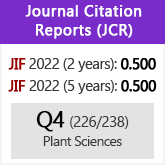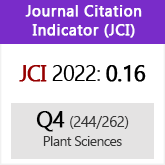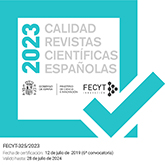Characterization of mycorrhizal fungi of the genus Tulasnella (Tulasnellaceae, Basidiomycota) in the genus of orchids Bletia from Barranca del Cupatitzio Natural Reserve, Mexico
DOI:
https://doi.org/10.3989/ajbm.2491Keywords:
ITS, Rhizoctonia-like fungal complex, terrestrial orchids, Tulasnella, orchid-fungal partnershipAbstract
The goal of this study was the identification of mycorrhizal fungi associated with three terrestrial orchids of the genus Bletia Ruiz & Pav.: B. roezlii Rchb. f., B. purpurata A.Rich., and B. punctata Lex., in Barranca del Cupatitzio Natural Reserve - Michoacán, México - . Thirty-nine strains were isolated and morphologically characterized. Nine strains were selected from the molecular analysis. Bletia punctata, an endemic species of Mexico, showed the lowest variability in mycorrhizal fungi. Morphological analysis showed that 39 isolated strains belong to the ‘Rhizoctonia-like fungal complex’. According with the tree of Euclidian distances generated by the analysis WARD, all isolates were included into four subgroups, all related to the genus Tulasnella J.Schröt - which belongs to the ‘Rhizoctonia-like fungal complex’?. Molecular and phylogenetic analysis of the nine selected strains corroborated the results of the morphological study: the sequences obtained were clustered in four subclades related to species of Tulasnella. Our results indicate that a single species of Bletia from a single locality can be associated with different species of mycorrhizal fungi, at least during the adult stage and that the combination of morphological and molecular analyses is a good tool to identify orchid mycorrhizal fungi.
Downloads
References
Bello-González M.A & Madrigal-Sánchez X. 1996. Estudio florístico del campo experimental "Barranca del Cupatitzio", Uruapan, Michoacán. INIFAP [folleto científico n.º 2], Uruapan.
Beltrán-Nambo M.A., Ortega-Larrocea M.P., Salgado-Garciglia R., Otero-Ospina J.T., Martínez-Trujillo M. & Carreón-Abud Y. 2012. Distribution and abundance of terrestrial orchids of the genus Bletia in sites with different degrees of disturbance, in the Cupatitzio Natural Reserve, Mexico. International Journal of Biodiversity and Conservation 4 (8): 316–325.
Clements M.A. 1988. Orchid mycorrhizal associations. Lindleyana 3: 73–86.
Cruz D., Suárez J.P. & Piepenbring M. 2014. Cryptic species revealed by molecular phylogenetic analysis of sequences obtained from basidiomata of Tulasnella. Mycologia 106 (4): 708–722. https://doi.org/10.3852/12-386 PMid:24874921
Cruz D., Suárez J.P., Kottke I. & Piepenbring M. 2016. Morphological revision of Tulasnellaceae, with two new species of Tulasnella and new records of Tulasnella spp. for Ecuador. Nova Hedwigia 102 (3–4): 279–338. https://doi.org/10.1127/nova_hedwigia/2015/0304
Currah R.S., Sigler L. & Hambleton S. 1987. New records and new taxa of fungi from the mycorrhizae of terrestrial orchids of Alberta. Canadian Jounal of Botany 65: 2473–2482. https://doi.org/10.1139/b87-336
Currah R.S., Zelmer C.D., Hambleton S. & Richardson K.A. 1997. Fungi from orchid mycorrhizas. In Arditty J. & Pridgeon A. (eds.), Orchid Biology, Reviews and Perspectives VII. Kluwer Academic Publishers, Dordrecht. https://doi.org/10.1007/978-94-017-2498-2_4
Davidson R.W., Cambell W.A. & Blaisedel D.J. 1938. Differentiation of wood-decaying fungi by their reactions on gallic or tannic acid medium. Journal Agriculture Research 57: 683–695.
Dearnaley J.D., Martos F. & Selosse M.A. 2012. Orchid mycorrhizas: Molecular ecology, evolution and conservation aspects. In Hock B. (ed.), The Mycota IX: 207–230. Springer, Berlin.
Edgar R.C. 2004. MUSCLE: a multiple sequence alignment method with reduced time and space complexity. Bioinformatics 5 (113): 1–19.
Goloboff P.A., Farris J.S. & Nixon K.C. 2008. TNT, a free program for phylogenetic analysis. Cladistics 24: 774–786. https://doi.org/10.1111/j.1096-0031.2008.00217.x
Govaerts R., Bernet P., Kratochvil K., Gerlach G., Carr G., Alrich P., Pridgeon A.M., Pfahl J., Campacci M.A., Baptista D.H., Tigges H., Shaw J., Cribb P., George A., Kreuz K. & Wood J. 2016. World Checklist of Orchidaceae Family. Website: http://apps.kew.org/wcsp/ [accessed XI-2016].
Jacquemyn H., Brys R., Lievens B. & Wiegand T. 2012. Spatial variation in below-ground seed germination and divergent mycorrhizal associations correlate with spatial segregation of three co-occurring orchid species. Journal of Ecology 100 (6): 1328–1337. https://doi.org/10.1111/j.1365-2745.2012.01998.x
Kumar P.M., Pagano M. & Donovan O. 2017. Biotechnological advances of beneficial fungi for plants. Mycosphere 8 (3): 445–455. https://doi.org/10.5943/mycosphere/8/3/6
Mageto O.E., Kamweya M.A., Ochora M.J. & Maobe S.N. 2014. Effects of symbiotic fungi on distribution and abundance of the epiphyitic orchid Polystachya fusiformis (Thou.) Lindl. in the manga range ecosystem, Kisii, Kenya. Journal of Applied Phytotechnology in Environmental Sanitation 3 (2): 45–54.
McCormick M.K. & Jacquemyn H. 2014. What constrains the distribution of orchid populations? New Phytologist 202 (2): 392–400. https://doi.org/10.1111/nph.12639
Mitchell R. 1989. Growing hardy orchids from seed at Kew. The Plantsman 3 (2): 152–169.
Müller J., Muller K., Neinhuis C. & Quandt D. 2005. PhyDE: Phylogenetic Data Editor. Website: www.phyde.de [accessed 16-XII-2016].
Munsell. 2000. Soil Color Charts. GretagMacbeth. 617 Life Britain Road, New Windsor.
Nogueira R.E., van den Berg C., Pereira O.L. & Kasuya M.M. 2014. Isolation and molecular characterization of Rhizoctonia-life fungi associated with orchid roots in the Quadrilátero Ferrífero and Zona da Mata regions of the state of Minas Gerais, Brazil. Acta Botánica Brasilica 28 (2): 298–300. https://doi.org/10.1590/S0102-33062014000200017
Oberwinkler F., Cruz D. & Suárez J.P. 2017. IBiogeogrphy and Ecology of Tullasnelaceae. In Caldwell M.M., Canadell J.G., Díaz S., Heldmaier G., Jackson R.B., Levia D.F., Schulze E.-D., Sommer U. & Wardle D.A. (eds.), Ecological Studies 230: 237–271. Springer, Berlin. PMid:28826482 PMCid:PMC5593507
Ortega-Larrocea M.P. 2008. Propagación simbiótica de orquídeas terrestres con fines de restauración edafológica. In Álvarez-Sánchez J. & Monroy-Ata A. (eds.), Técnicas de estudio de las asociaciones micorrízicas y sus implicaciones en la restauración: 85–96. Facultad de Ciencias UNAM, Ciudad de México.
Ortega-Larrocea M.P. & Rangel-Villafranco M. 2007. Fungus assisted reintroduction and lon-term survival of two Mexican terrestrial orchids in the natural habitat. Lankesteriana 7 (1–2): 317–321.
Ortega-Larrocea M.P. & González D. 2008. Los hongos asociados a las orquídeas terrestres en la restauración. In Heredia A.G. (ed.), Tópicos sobre diversidad, ecología y usos de los hongos microscópicos en Iberoamérica: 305. Instituto de Ecología A.C., Veracruz.
Otero J.T., Mosquera A.T. & Flanagan N.S. 2013. Tropical orchid mycorrizae: potential in orchid conservation, commercialization and beyond. Lankesteriana 13 (1–2): 57–63.
Pandey M., Sharma J., Taylor D.L. & Yadon V.L. 2013. A narrowly endemic photosynthetic orchid is non-specific in its mycorrhizal associations. Molecular Ecology 22 (8): 2341–2354. https://doi.org/10.1111/mec.12249 PMid:23432406
Pereira O.L., Megumi K.M., Chaer B.A. & Fernandes de Araújo A.E. 2005. Morphological and molecular characterization of mycorrhizal fungi isolated from Neotropical orchids in Brazil. Canadian Journal of Botany 83: 54–65. https://doi.org/10.1139/b04-151
Pereira M.C., Coelho I.S., Valadares R.B.S., Oliveira S.F., Bocayuva M., Pereira O.L., Araujo E.F. & Kasuya M.K. 2014. Morphological and molecular characterization of Tulasnella spp. fungi isolated from the roots of Epidendrum secundum, a widespread orchid. Symbiosis 62: 111–121. https://doi.org/10.1007/s13199-014-0276-0
Posada D. 2008. jModelTest: Phylogenetic Model Averaging. Molecular Biology and Evolution 25 (7): 1253–1256. https://doi.org/10.1093/molbev/msn083 PMid:18397919
R-Development Core Team. 2008. R: a language and environment for statistical computing. R Fundationfor Statistical Compiuting, Vienna. Website: http//www.R-proyect.org [accessed 5-IX-2016].
Rasmussen H.N. & Rasmussen F.N. 2007. Trophic relationships in orchid mycorrhiza-diversity and implications for conservation. Lankesteriana 7 (1–2): 334–341.
Ronquist F., Teslenko M., Mark P.V., Ayres D.L., Darling A., Höhna S., Larget B., Liu L., Suchard M.A. & Huelsenbeck J.P. 2012. MrBayes 3.2: Efficient Bayesian Phylogenetic Inference and Model Choice Across a Large Model Space. Systematic Biology 61 (3): 539–542. https://doi.org/10.1093/sysbio/sys029 PMid:22357727 PMCid:PMC3329765
Schatz B., Geoffroy A., Dainat B., Bessière J., Buatois B., Hossaert-McKey M. & Selosse M. 2010. A case study of modified interactions with symbionts in a hybrid mediterranean orchid. American Journal of Botany 97 (8): 1278–1288. https://doi.org/10.3732/ajb.0900303 PMid:21616880
SEMARNAT. 2010. Norma Oficial Mexicana NOM-059-ECOL-2001: Protección ambiental-Especies de flora y fauna silvestres de México-Categorías de riesgo y especificaciones para su inclusión, exclusión. Lista de especies en riesgo. Diario Oficial de la Federación [6-III-2010], México.
Shan X.C., Liew E.C., Weatherhead M.A. & Hodgkiss J.J. 2002. Characterization and taxonomic placement or Rhizoctonia-like endophytes from orchid roots. Mycologia 94 (2), 230–239. https://doi.org/10.1080/15572536.2003.11833228 PMid:21156492
Sneh B., Burpee L. & Ogoshi A. 1991. Identification of Rhizoctonia species. American Phytopathological Society Press, Minnesota.
Sosa V. 1992. Neotificación de tres especies del género Bletia (Orchidaceae). Acta Botánica Mexicana 18: 71–79. https://doi.org/10.21829/abm18.1992.644
Suárez J.P. & Kottke I. 2016. Main fungal partners and different levels of specificity of orchid mycorrhizae in the tropical mountain forests of Ecuador. Lankesteriana 16 (2): 299–305. https://doi.org/10.15517/lank.v16i2.26014
Swarts N.D., Sinclair E.A., Francis A. & Dixon K.W. 2010. Ecological specialization in mycorrhizal symbiosis leads to rarity in an endangered orchid. Molecular Ecology 19: 3226–3242. https://doi.org/10.1111/j.1365-294X.2010.04736.x PMid:20618899
Taylor D.L., Bruns T.D., Szaro T.M. & Hodges S.A. 2003. Divergence in mycorrhizal specialization within Hexalectris spicata (Orchidaceae), a nonphotosynthetic desert orchid. American Journal of Botany 90: 1168–1179. https://doi.org/10.3732/ajb.90.8.1168 PMid:21659217
Valadares R.B.S., Pereira M.C., Otero J.T. & Cardoso E.J.B.N. 2012. Orchid mycorrhiza diversity in Coppensia doniana, a widespread Oncidiinae from campos de Jordao-SP Brazil. Biotropica 44: 114–122. https://doi.org/10.1111/j.1744-7429.2011.00769.x
Valadares R.B.S., Otero J.T., Pereira M.C. & Cardoso E.J.B.N. 2015. The epiphytic orchid Ionopsis utricularioides and Psygmorchis pusilla associate with different Ceratobasidium lineajes at Valle de Cauca, Colombia. Acta Botanica Brasilica 29 (1): 40–44. https://doi.org/10.1590/0102-33062014abb3397
White T.J., Burns T., Lee S. & Taylor J. 1990. Amplification and direct secuencing of fungal ribosomal RNA genes for phylogenetics. In Innis M.A., Gelfand D.H., Sninsky J.J. & White T.J. (eds.), PCR Protocols: A Guide to Methods and Applications: 315–322. Academic Press, New York.
Whitman M. &. Ackerman J.D. 2015. Terrestrial orchids in a tropical forest: best sites for abundance differ from those for reproduction. Ecology 96 (3): 693–704. https://doi.org/10.1890/14-0104.1
Xing X., Ma X., Deng Z., Chen J., Wu F. & Guo S. 2013. Specificity and preference of mycorrhizal associations in two species of the genus Dendrobium (Orchidaceae). Mycorrhiza 23: 317–324. https://doi.org/10.1007/s00572-012-0473-8 PMid:23271631
Zavala-Álvarez C. 2006. Pteridoflora del Parque Nacional Barranca del Cupatitzio, Uruapan, Michoacán, México. Dissertation, Universidad Michoacana de San Nicolás de Hidalgo, Mexico.
Zelmer C.D. 1994. Interactions between northern terrestrial orchids and fungi in nature. PhD. Dissertation, University of Alberta, Canada.
Zettler L.W., Sharma J. & Rasmussen F. 2004. Mycorrhizal diversity. In Dixon K., Cribb P., Kell S. & Barret R. (eds), Orchid Conservation: 185–203. Natural History Publications, Kota Kinabalu. PMCid:PMC1494788
Published
How to Cite
Issue
Section
License
Copyright (c) 2018 Consejo Superior de Investigaciones Científicas (CSIC)

This work is licensed under a Creative Commons Attribution 4.0 International License.
© CSIC. Manuscripts published in both the printed and online versions of this Journal are the property of Consejo Superior de Investigaciones Científicas, and quoting this source is a requirement for any partial or full reproduction.All contents of this electronic edition, except where otherwise noted, are distributed under a “Creative Commons Attribution 4.0 International” (CC BY 4.0) License. You may read here the basic information and the legal text of the license. The indication of the CC BY 4.0 License must be expressly stated in this way when necessary.
Self-archiving in repositories, personal webpages or similar, of any version other than the published by the Editor, is not allowed.

















